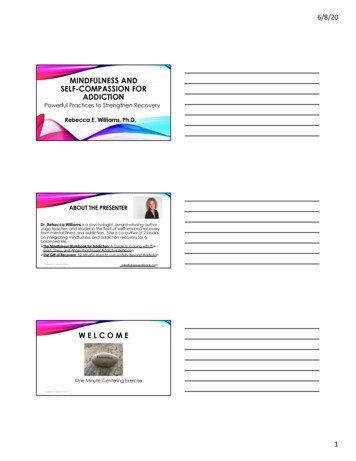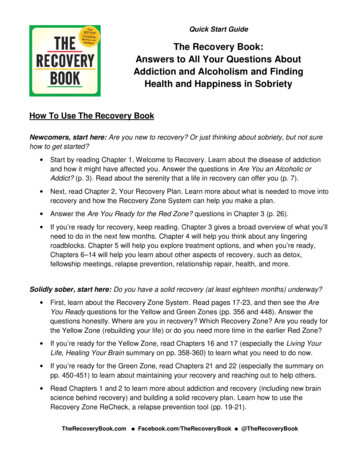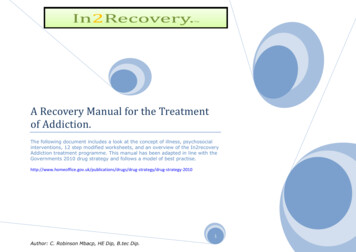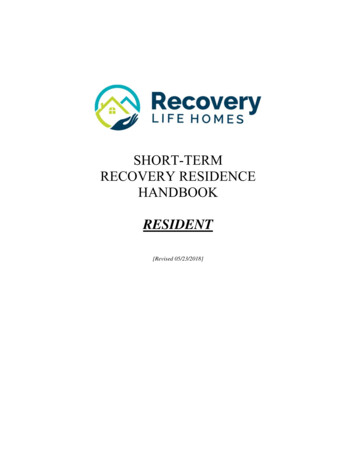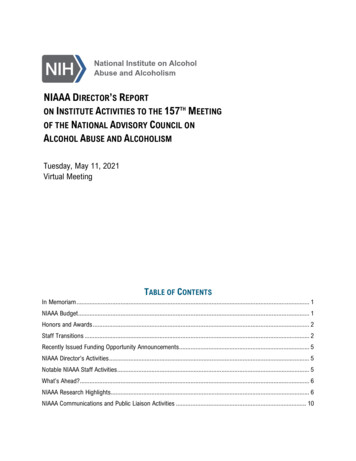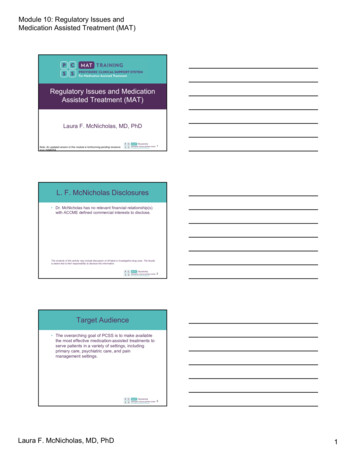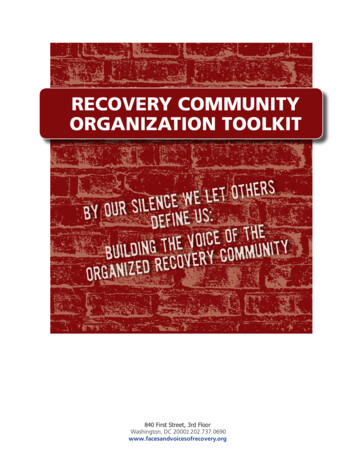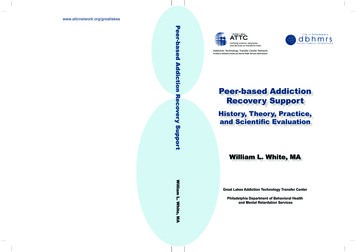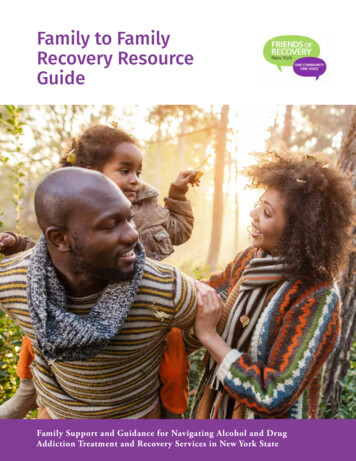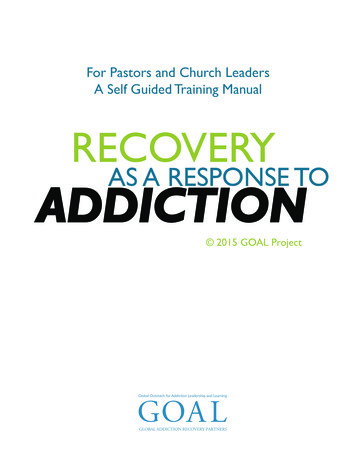
Transcription
For Pastors and Church LeadersA Self Guided Training ManualRecoveryas a Response toAddiction 2015 GOAL Project
Recovery as a Response to AddictionTable of Contents 1Introduction. 3Section One. 7Section Two.23Section Three.33Section Four.39Page 1
Recovery as a Response to AddictionAcknowledgmentThis manual was originally designed by Ron Hunsicker, a former pastor and GOAL missionary. Fortwelve days in January of 2012 Ron served as a missionary in Ghana and Togo, West Africa at theinvitation of Pastor David Botchway. Alongside Pastor Botchway, Seth Dzadra, Redeemer Tulabor,and a host of pastors and church leaders he facilitated three two-day workshops on the topic ofRecovery as the Church’s response to Alcoholism and Other Drug (AOD) addiction. At the endof the training the participants asked him if he would put down on paper the information that heshared with them.For everyone who participated in any of GOAL’s workshops you were the ones that wrote thismanual. God has blessed you and will continue to bless you in this vital healing ministry. For pastorsand church leaders anywhere and everywhere, this current manual, now edited, is the culminationof years of experience of GOAL missionaries working and planting recovery support groups allover the world.Page 2
Recovery as a Response to AddictionIntroductionThe Gospel narrative suggests that prior to the public ministry of Jesus the Christ, he spent 40days in the wilderness. During that time he prayed, fasted, and examined himself. Some of theimportant questions he asked himself were: What sort of Messiah am I going to be? What does it mean for me to be the Son of God? What does God, the Father, want me to be?Perhaps it was this last question that was the most important! What was it that God wanted fromand of him? It really did not matter what sort of Messiah he wanted to be, but it did matter whatsort of Messiah God wanted him to be!The Gospels of Matthew, Mark, and Luke report on this “wilderness” experience by Jesus. It isLuke that gives us the most insight into how Jesus shared with the people what happened to himwhile he was in the wilderness. At the end those 40 days, Jesus returned to Galilee and then toNazareth and read the passage selected for that day in the synagogue. Reading from the prophetIsaiah he read:“The Spirit of the Lord is upon me because he has anointed me; he has sent me to announce goodnews to the poor, to proclaim release for prisoners and recovery of sight for the blind; to let thebroken victims go free, to proclaim the year of the Lord’s favour.” (Luke 4:18-19 NEB)The ministry of reaching out to an addict and his/her family is a ministry that has a central focusof being called. We do what we do today and what we have been doing for the last twenty years,not because we want to, but because we have been called! Are you called to love the unlovable? Are you called to love those who may never love you back?Jesus made it very clear that he sensed a deep, deep call to carry out what God was revealing tohim, to love others in ways that the world had never seen before; the same calling that you mayhave experienced.Page 3
Recovery as a Response to AddictionAs you work through this manual or take part in one of our workshops you will be asked toexamine some new concepts, practice some new ways of responding, and explore your own innersoul in ways you never thought possible. You will be scared, angry, and perhaps wanting to leave.But if you stick with it, if you allow that call to steer your life, you will have an opportunity to walka spiritual journey with persons who will touch you, who will move you, who will frustrate you,and who will teach you.As pastors we need to find a way to offer hope and recovery to those persons in our families,in our churches, and in our communities who have the disease of addiction. We learn from eachother, but more importantly, we learn from those persons around us who have tried to fill a “holein their soul” with alcohol, with gambling, with drugs, with sex or with other addictions that onlybring shame, guilt, and fear. When the Church reaches out and builds communities of trust, hope,and love, she begins to create a place for persons to be “loved back to wholeness.”Terms in this manual may not be understood by you and you may want to come up with wordsor terms that work best in your community and in your setting. We ask you now to be open to learning. And to examine your beliefs and values. We will ask you to participate and listen in recovery support groups. And we will ask you to pray for wisdom and understanding of those persons who have thedisease of addiction.In this training manual, we will focus on five major topics. They will include:1. Alcohol or other Drug (AOD) Addictions2. Addictions as Brain Diseases3.The Spiritual Recovery Journey of the 12 Steps4. Recovery Groups: What they are and are not5. Step 4, 5, and 6A leader is someone who does not ask persons to do or go where he/she is not willing to go. Ifwe want to invite persons with addictions to begin the one-day-at-time journey of recovery, thenwe also need to be willing to take that journey ourselves. Each of our journeys will be different,but all of us will be looking for some healing of the pain deep inside of us that keeps us from beingwhole. If you are willing to take a journey with us, please read on.Page 4
Recovery as a Response to AddictionBefore we begin we need to figure out where we arebeginning from and what it is that we want to do with whatwe learn and discover. In order to do this, we ask that youthink about the following three questions: What do I know about addictions? What do I want to learn? What will I do with what I learn?Take a pen or pencil and write down your answers to these questions, what it is you already knowabout this disease, what you want to learn, and what you are willing to commit yourself to doingafterwards. There are no right or wrong answers .only your answers! Take your time.You are now ready to continue.Page 5
Recovery as a Response to AddictionPage 6
Section One
Recovery as a Response to AddictionPage 8
Recovery as a Response to AddictionAOD Addiction as a Disease“People who have recovered from addiction to alcohol and other drugs are aware of the futilityof trying to find nirvana via mind-altering chemicals. Most recovering people active in Twelve Stepprograms such as A.A. have also come to the realization that if they lead a life devoid of spirituality,they will likely relapse into chemical abuse. The challenge facing the clergy is to impress uponthose who have not yet fallen prey to chemical addiction that spirituality rather than ‘feeling good’must be the ultimate goal in life.” (Rabbi Abraham Twerski, MD,1990, p.7)AOD addiction is a primary, chronic disease with genetic, psychosocial, and environmental factorsinfluencing its development and manifestations. Addiction comes at the end of a spectrum fromuse to abuse (or misuse) of AOD and includes opiate pain prescriptions. The disease is oftenprogressive and fatal. It is characterized by continuous or periodic impaired control over drinkingor drugging; preoccupation with the AOD; the use of AOD despite adverse consequences; anddistortions in thinking, most notably denial. Each of these symptoms may be continuous or periodic.AOD use can be understood as a continuum ranging from having never smoked or used alcoholor another drug at one end to having an unmanaged chronic, relapsing disease at the other.Page 9
Recovery as a Response to AddictionHow easy it is to spend your time talking about all the “problems” that are caused by people whomisuse AOD. If you were asked, you could probably identify a whole list of “community troublemakers” and in most cases AOD would be involved. But we are not going to focus on the “blacksheeps”—addicts in our ancestry may have been called! We are going to focus on our relatives,friends, and parishioners who have a disease!The key phrases are:AOD (Alcohol and Other Drugs)andAddiction (in bondage)What are your first thoughts or ideas you have when you hear these two?We are going to give our primary attention to those persons who have the AOD disease. Thereare other addictions such as sex, food, and gambling that take similar destructive paths and arealso addiction diseases. Those who have the disease of addiction are different from those who donot have this particular disease, such as chronic heart disease, diabetes, cancer, or a mental illness.Some who have the addiction disease also have a mental or physical illness. They do not knowwhy they have their disease. But the medical specialists have diagnosed their illness. Whatever thediagnosis the person with the disease needs to make changes to his/her life style and to rearrangehis/her daily lives to keep the disease in remission.Persons who have the AOD disease of addiction need to learn how to manage their disease oneday at a time for the rest of their life. That life long process is called Recovery!Doctors set broken arms and broken legs and prescribe medications, but they cannot curediabetes, chronic heart disease, a mental illness or the disease of addiction. Addicts manage theirdisease! It never goes away. Our ministry is to help them manage their disease - a disease that hasthat has physical, psychological, relational, and spiritual components through recovery.Page 10
Recovery as a Response to AddictionWhat do we know?We know that 1 out of every 10 persons who drink becomes an alcohol addict! We know that 1out of every 4 persons suffers from a loved one’s alcohol addiction! We know that heroin and painmedications are opiates. We know that smoking cigarettes and marijuana leads to dependency.Think about how many people worship in your congregation, how many might be suffering andneed healing. Think about how many others may be suffering from a gambling or sex addiction orabuse from an addict. An epidemic? Yes, and right in your congregation.Look out over your congregation the next time you preach and notice the teenagers. Are theypopping pain pills or shooting heroin? Addiction to opiates, pain medications, and heroin arepervasive in the United States. More DUI arrests are made for heroin than alcohol. What aboutyour seniors? How many of them drink alcohol with their sleeping pills? In African countries, besidesalcohol, khat and marijuana are grown for economic gain and readily available. In Afghanistan andPakistan, poppies are grown for the prolific heroin trade.If you want to know who is an addict, you need to be willing to sit down next to one and lookhim/her in the eye. Face to face eye to eye and ask him/her:1. Have you ever tried to quit drinking or using drugs*?2. Have you ever gotten into trouble when you were drinking or using drugs?3. Has anyone ever told you he/she was concerned about your drinking or usingdrugs?*include pain medicationsIf you look into enough eyes, you will know. It is not the answer to the questions; it is the lookinginto the eyes that will tell you. The first step in helping addicts is being able to sit next to them,look them in their eyes and say; “I am going to ask you some questions, because I love you somuch that I do not want you to die.” If an alcohol addict does not get help he will die. If ateenage opiate addict doesn’t get help, he/she will lie, steal, and skip school or have falling grades.Your seniors who are using may fall or may be misdiagnosed with dementia.The second thing that we know is that addiction is a brain disease. Brains of AOD addicts actdifferently than those of persons who are not AOD mis-users. We did not know this twenty yearsago, but we know it now.How do we know it? We know it because we can take pictures of brains and measure the electricalactivity. That activity is different— very different. Other organs are damaged too.Page 11
Recovery as a Response to AddictionBrain DiseaseUsing AOD repeatedly over time changes brain structure and function in fundamental andlong-lasting ways that can persist long after the individual stops using drugs. These changes areresponsible for the distortions of cognitive and emotional functioning including the compulsionto drink alcohol or use drugs. The individual, once addicted, has moved into a different state ofbeing; a threshold has been crossed. This same pattern, this same disruption, is seen in picturesof the brains of heroin addicts.Page 12
Recovery as a Response to AddictionPage 13
Recovery as a Response to AddictionNeurobiological researchers (NIDA) have given us these diagrams to use in understanding whathappens to an individual who is an AOD addict. Their important scientific discoveries have helpedus understand that addicts are not “bad”, instead they are people who have a disease and whodeserve to be respected and treated just as persons with cancer, diabetes, heart disease, orParkinson’s! When the circuits in an addict’s brain light up differently, it means that their cravingneeds to be satisfied with trust, and hope, and love instead of AOD! So what difference does any of this make to me? Does it make a difference that some members of my congregation may havebrains that function differently than mine? Do I treat those in my congregation who have an addiction disease the sameas some who have cancer or heart disease? Do we as a congregation pray forthem?Page 14
Recovery as a Response to AddictionNot only do we need to think about addicts, but we must also pay attention to their families.Entire families begin to adjust and adapt to the addiction disease and, in the process, they becomedysfunctional.We hear a lot these days about family values and healthy marriages. And what about the childrenwho join us for Sunday School and listen to our children’s sermons? Do we know what really goeson in their homes? How do we know they are not being abused? Children who have one or morefamily members who are addicts experience emotional (and often physical and sexual) abuse andneglect. These children do not know what it is like to live in a healthy family! What might seemhealthy to them might be very dysfunctional.So now comes the time in your quest for understanding to explore how you grew up. You willnow think about the following questions: What did I learn about how to be family? Did you consider your family life normal? Why or why not?Page 15
Recovery as a Response to AddictionHere are some characteristics of a healthy family(Adapted from Bradshaw, On the Family. April, 1990)Five Freedoms Expressed—In order to be fully functional, each human being needs to expressfreely the five basic powers that constitute human strength. These are: the power to perceive; tothink and interpret; to emote; to choose, to want and desire; and to be creative through the useof imagination.Unfolding Process of Intimacy—Marriage, the chief component of the family, needs to be inthe process of becoming intimate. This process goes through the stages of: in love; working outdifferences; compromise and individualization; and plateau intimacy.Negotiated Differences—Negotiating differences is the crucial task in the process of intimacyfoundation. To negotiate differences there must be the desire to cooperate. This desire createsthe willingness to fight fair.Clear and Consistent Communication—Clear and consistent communication are keys toestablishing separateness and intimacy. Clear communication demands awareness of self and theother as well as mutual respect for each other’s dignity.Trusting—Trust is created by honesty. Accurate expression of emotions, thoughts, and desiresis more important than agreement. Honesty is self -responsible and avoids shaming.Individuality—In healthy families differences are encouraged.The uniqueness and unrepeatabilityof each person is the number one priority.Open and Flexible—In a healthy family the roles are open and flexible. One can be spontaneouswithout fear of shame and judgment.Needs Fulfilled—Healthy people are getting their needs met. A functional family allows all of itsmembers to get their needs filled.Accountability—Healthy families are accountable. They are willing to acknowledge individualproblems, as well as family problems. They will work to resolve those problems.Rules Are Open and Flexible—The rules will allow for mistakes. Rules are negotiable. 12Here is another list of characteristics that make a healthy familyR-E-S-P-E-C-T— Respect is the “Holy Grail” of healthy families.All people in the family, brothersto sisters, mothers to fathers, parents to kids must be respectful as consistently as possible. Beingconsiderate of each other is the tie that binds, even more than love.Page 16
Recovery as a Response to AddictionAn Emotionally Safe Environment— All members of the family can state their opinions,thoughts, wants, dreams, desires and feelings without fear of being slammed, shamed, belittled ordismissed.A Resilient Foundation— When relationships between and amongst people in a family arehealthy they can withstand stress-even trauma- and if not bounce back, at least recover. Resiliencestarts with encouraging sound physical health, eating and sleeping well, and activity.Privacy— Boundaries of space, of body, and of thought are respected. Family members knockand ask permission to enter before going through a closed door. All family members are sensitiveregarding personal space and aren’t insulted if someone needs wider personal boundaries.Accountability— Being accountable is not the same as planting a homing device on your childor abusing the cell phone to track her whereabouts 24/7. That’s not much better than stalking.No, being accountable means respectfully and reasonably informing people in the family whereyou are and what you are doing so they can grow trust and not worry.An Apology— Sometimes individuals hold out for an apology on a point of pride while neveracknowledging their part in a dispute. How many times have you heard of rifts in families that lastfor years because someone feels they are owed an apology?Resolving Conflicts—A healthy family will have conflict. When arguments occur and arediscussed, members can still be friendly afterwards. Sometimes one may say things he/she regrets.If the one causing the hurt can feel and show remorse, quickly apologize, and ask for and receiveforgiveness, no harm is done. Parties in the conflict may even become closer for it.Allow Reasonable Expression of Emotions— When some of us were growing up we weretold that Christians aren’t allowed to be angry or, for boys, that “big boys don’t cry.” Parents needto teach and model to their children how to state their anger in a managed manner with healthyways of dealing with angry feelings and that crying is God’s way of healing pain and hurt.Gentle on Teasing and Sarcasm— Teasing can be acceptable as long as the teased person is inon the joke; the same with sarcasm. A functional family won’t use either as a put down.Allows People to Change and Grow—Sometimes a child is labeled as being the smart oneor the pretty one, the funny one, or the shy one. Labeling needs to be checked. A healthy familylets family members define themselves. Individual differences are appreciated, even celebrated.Children can become independent when it’s appropriate and come back to the safety of the familywhen they need nurturing.Page 17
Recovery as a Response to AddictionBelow you will see a diagram that is our attempt to represent a healthy family. All family membersare connected to each other, but at the same time they give each other enough space to growand to develop their own “selves”. They support and encourage each other and remain in touchwith one another. This is only a diagram, but it begins to suggest how we are to be together in ahealthy family.In an addicted family, relationships are not healthy.We find that the entire family begins to functionin some strange ways. We call this kind of family a Codependent Family.Here’s a definition of a Codependent Family.“Intergenerational patterns of living and problem solving that are formed within a family systemwhere there is or has been various dysfunctional patterns that include chemical abuse ordependence. The system then supports dependence and counter dependence in interpersonalrelationships with a loss of individual autonomy and a distortion of reality.” (from Webb- FabeanCodependence in Family Systems Guide,1999 )Page 18
Recovery as a Response to AddictionIf the addicted person(s) in the family finds treatment and recovery, the rest of the family maystill continue to have these Codependent characteristics as they have assumed roles to adapt tothe AOD addiction disease. Family members are in as much need of love, care, and support as theaddict- if not more so!You may recall the story of the Prodigal Son in Luke 15:11-32. Although the focus has been on theFather reaching out to embrace the son who stole his inheritance and squandered it in riotousliving, the older son has been the neglected one. Two of the roles in codependent families are thehero child who does everything right and the spouse who normally functions as the caretaker.Yet the older son, the one who does everything right, expresses resentment and anger at all theattention paid to the profligate son. Many pastors, church lay leaders, medical and mental healthprofessionals can identify with these two roles and need recovery.Here’s a model of the difference between how healthy families and Codependent families dealwith feelings and relationships.Here are some characteristics of Codependent FamiliesInterference and control by one of more senior family members who have set unhealthypatterns and traditions that must be followed. These lead to enmeshment or disengagement. Forexample, the addicts in earlier generations may be called “black sheep.”Page 19
Recovery as a Response to AddictionLacking intimacy or not being able to share private thoughts, feelings, and wants because of thefear of being hurt or being abused. Feelings are buried and lead to depression and other mentalhealth problemsControlling or being controlled is at the core of a codependent family system. The addictexerts the power and the dependent spouse exerts control so there are no shared decisions andthere are escalating conflicts. Manipulation often occurs.Triangulation with a child who is usually caught in the web between conflicted parents.Evidence of AOD (legal or illegal) misuse and abuse that causes social, economic, andrelationship problems. The spouse of an addict may find relief and become obsessed in church orcommunity causes.Enabling from family members who cover for and take care of the addict, often assuming theresponsibilities and choices an addict needs to make or take for him or herself. The addictedperson blames other family members for his/her problems. Those family members or even wellmeaning friends cover for, placate, or protect the addict seeking to uphold the family honor anddistracting outsiders from seeing the problems. Addiction is often called the “elephant” in theliving room that no one talks about or has been sworn to never talk about the addition behaviorto anyone outside the family circle. Secrecy surrounds the addict’s behavior as well as resultantmental, physical, or sexual abuses that may be occurring.Indirect or Reactive Communication with judgmental and global overtones. Differingopinions are not acceptable. One person is right; the others cannot question. Communicationescalates into violent arguments and scenes.Emotional Affect is Flat or Frozen so that appearances are never reality. Suppressed negativefeelings create toxic shame-based individuals. When terrible events occur, the family memberssmile and say, “It’s God’s Will.”No Validation results in a lack of healthy development of individual family member self worth.High Stress and Anxiety yields mental and physical problems. Crisises occur frequently andone person— usually the oldest child or the spouse— assumes fixing the crisis. High stress causesmultiple mental and physicial health problems.Unresolved Intergenerational and Sibling conflict growing worse with each succeedinggeneration.No Trust, Mistrust, or Blind Trust makes family members susceptible to fraud, scams, and fearof intimate relationships.Page 20
Recovery as a Response to AddictionRoles are created to relieve the stress and keep the family functioning. These are defined invarious ways with identifiable characteristics even in small children. When these roles are carriedinto adult-life problems of relationships, boundaries, and employment occur.Rules are inconsistent, unfair or rigidly enforced.Discipline is often chaotic, violent and abusive.Intense Family interaction and competition leads to discomfort, frustration, and poor selfesteem.Rigid Religious Beliefs are enforced and become binding instead of liberating. In many situationsreligious cults develop around a dysfunctional, abusive leader.We are at the end of Section 1. Before you move ahead, take some time to think about andrespond to the following questions: What did I learn new in this section? What did I learn about how I view the families in my congregation? About myown family?Page 21
Recovery as a Response to Addiction What are my fears and concerns about what I might uncover? What did I lean that I need more information or help with? Am I ready to learn more about Addiction and Recovery?Page 22
Section Two
Recovery as a Response to AddictionPage 24
Recovery as a Response to AddictionThe 12 Steps as a Spiritual JourneyAny journey or any trip needs directions. If we do not have directions on how to get from here towhere we are going, how do we know when we have arrived? We can use a printed map or GPSto guide us to our destination, especially in a crowded city like New York.To find where we are going and to stay on the path takes guidance and practice. Recovery is nodifferent. It means following directions that are embodied in spiritual guidelines called the 12-Steps.For the addict and family members following these 12-Steps is a life-long spiritual journey calledRECOVERY. These are similar to an Ignation spiritual rule, a Benedictine Spiritual rule, or justfollowing in the steps of Jesus.Page 25
Recovery as a Response to AddictionBackgroundAlmost 100 years ago a physician (proctologist) and a successful business man discovered thattheir lives were in trouble. They both knew that they did not drink like normal people and thattheir drinking had caused much despair in their families and in their communities. They had bothtried many, many times to stop drinking. And then they found each other. Out of that friendshipcame the pledge I will help you not to drink today, if you will help me. Imagine what that must havebeen like. Two persons promising each other that they would help the other to not drink bytalking through their cravings. They did not promise forever, but just for today!It was out of this friendship, out of this helping each other to stay alive, that what we now referto as the 12 Steps were put on paper with the assistance of an Anglican pastor named SamShoemaker. They grew out of the Oxford Group Christian Renewal Movement’s principles andpractices. These 12 Steps are the footprints in the sand to follow or guidelines to use one day ata time. These steps show the transformative pathway to recovery.As has been noted, addicts have “holes in their souls” that need to be filled with something otherthan AOD, sex, or gamblingPage 26
Recovery as a Response to AddictionTHE TWELVE STEPS OF ALCOHOLICS ANONYMOUS1. We admitted we were powerless over alcohol—that our lives had becomeunmanageable.2. Came to believe that a Power greater than ourselves could restore us to sanity.3. Made a decision to turn our will and our lives over to the care of God as weunderstood Him.4. Made a searching and fearless moral inventory of ourselves.5. Admitted to God, to ourselves, and to another human being the exact nature ofour wrongs.6. Were entirely ready to have God remove all these defects of character. 27. Humbly asked Him to remove our shortcomings.8. Made a list of all persons we had harmed, and became willing to make amends tothem all.9. Made direct amends to such people wherever possible, except when to do so wouldinjure them or others.10. Continued to take personal inventory and when we were wrong promptly admittedit.11. Sought through prayer and meditation to improve our conscious contact withGod, as we understood Him, praying only for knowledge of His will for us and thepower to carry that out.12. Having had a spiritual awakening as the result of these Steps, we tried to carry thismessage to alcoholics, and to practice these principles in all our affairs. (Copyright:A.A. World Services, Inc.)As the 12 Steps began to guide those persons recovering from alcoholism, there emerged abook that explained the steps, that also contains stories about those who found hope andhealing through them, and that described their journeys to healing. The book became known asAlcoholics Anonymous: The Big Book. To access this book on line go to www.aa.org/bbonline/. Youcan download a complete copy of the book or y
ReCOveRy AS A ReSPOnSe TO ADDICTION Acknowledgment This manual was originally designed by Ron Hunsicker, a former pastor and GOAL missionary. For twelve days in January of 2012 Ron served as a missionary in Ghana and Togo, West Africa at the invitation of Pastor David Botchway. Alongside Pastor Botchway, Seth Dzadra, Redeemer Tulabor,
